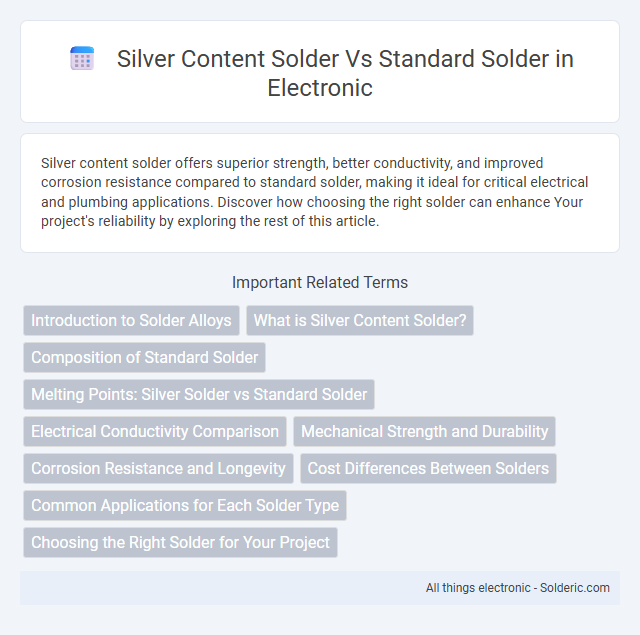Silver content solder offers superior strength, better conductivity, and improved corrosion resistance compared to standard solder, making it ideal for critical electrical and plumbing applications. Discover how choosing the right solder can enhance Your project's reliability by exploring the rest of this article.
Comparison Table
| Feature | Silver Content Solder | Standard Solder |
|---|---|---|
| Composition | Contains 1%-5% silver | Mostly tin and lead or tin and copper |
| Melting Point | Lower (around 217-221degC) | Higher (around 230-250degC) |
| Strength | High mechanical strength and durability | Moderate strength |
| Corrosion Resistance | Enhanced corrosion resistance | Standard corrosion resistance |
| Cost | Higher due to silver content | Lower, more economical |
| Application | Used in electronics, aerospace, and high-reliability joints | Common in general electronics and plumbing |
| Electrical Conductivity | Improved conductivity | Standard conductivity |
Introduction to Solder Alloys
Silver content solder alloys offer superior electrical conductivity and enhanced mechanical strength compared to standard tin-lead solders, making them ideal for high-reliability electronic connections. Standard solder typically consists of a tin-lead alloy with melting points around 183degC, while silver solders incorporate 1-4% silver, raising the melting point and improving thermal fatigue resistance. Your choice of solder alloy impacts joint durability, thermal performance, and overall circuit longevity.
What is Silver Content Solder?
Silver content solder is a type of solder alloy that contains a percentage of silver, typically ranging from 1% to 10%, mixed with other metals like tin and copper to enhance mechanical strength and thermal conductivity. It is commonly used in electronics, plumbing, and jewelry making because silver improves joint durability, electrical conductivity, and corrosion resistance compared to standard tin-lead or lead-free solders. The higher melting point of silver solder also enables reliable bonding in high-temperature applications, making it ideal for precision work requiring robust, long-lasting connections.
Composition of Standard Solder
Standard solder typically consists of a tin-lead alloy with compositions like 60/40 or 63/37, where the percentages represent tin and lead content, respectively. This composition offers a low melting point around 183degC to 190degC and good wetting properties for reliable electrical connections. Your choice between silver content solder and standard solder depends on specific application requirements, such as mechanical strength or corrosion resistance.
Melting Points: Silver Solder vs Standard Solder
Silver content solder typically has a melting point ranging from 620degF to 700degF (327degC to 371degC), which is higher than standard tin-lead solder melting at around 360degF (182degC). This elevated melting point in silver solder enhances joint strength and thermal stability, making it ideal for high-stress or high-temperature applications. Standard solder, with its lower melting temperature, is easier to work with but less suitable for environments requiring superior mechanical durability.
Electrical Conductivity Comparison
Silver content solder offers superior electrical conductivity compared to standard solder due to the addition of silver, which enhances electron flow and reduces resistance at the joint. With typically 2-5% silver content, this solder ensures more reliable connections in high-performance electronic applications, making it ideal for sensitive circuitry. Your choice of solder can significantly impact signal integrity and overall device efficiency, especially in precision electronics.
Mechanical Strength and Durability
Silver content solder offers superior mechanical strength and enhanced durability compared to standard solder due to its higher melting point and alloy composition, which provides better resistance to thermal cycling and mechanical stress. This increased strength makes silver solder ideal for high-stress applications requiring reliable, long-lasting joints in electronics, plumbing, and metalwork. Your projects benefit from reduced joint failure and improved overall structural integrity when opting for silver content solder.
Corrosion Resistance and Longevity
Silver content solder exhibits superior corrosion resistance compared to standard solder, significantly reducing the risk of oxidation and ensuring a stable electrical connection over time. Its enhanced longevity is attributed to silver's inherent anti-corrosive properties, which protect joints in harsh environments and extend the lifespan of electronic components. This makes silver-rich solder ideal for applications demanding reliability and durability under exposure to moisture and chemicals.
Cost Differences Between Solders
Silver content solder typically costs more than standard solder due to the higher price of silver as a raw material and its enhanced performance characteristics in conductivity and mechanical strength. Standard solder, usually composed of tin-lead or tin-copper alloys, offers a more economical option but may lack the superior thermal and electrical properties provided by silver alloys. The increased cost of silver solder is justified in high-reliability applications such as aerospace and electronics manufacturing where durability and performance are critical.
Common Applications for Each Solder Type
Silver content solder is commonly used in plumbing, HVAC, and electronics industries where strong, high-temperature, and corrosion-resistant joints are essential, such as in refrigeration systems and high-performance electrical connections. Standard solder, typically made of tin-lead or lead-free alloys, is preferred for general electronics assembly, circuit board repairs, and low-temperature applications due to its ease of use and lower cost. The enhanced mechanical strength and thermal conductivity of silver solder make it ideal for demanding applications, while standard solder suits everyday electrical and metal joining tasks.
Choosing the Right Solder for Your Project
Silver content solder offers superior mechanical strength and improved electrical conductivity compared to standard solder, making it ideal for precision electronics and high-stress applications. Standard solder, typically composed of tin and lead or lead-free alternatives, provides adequate performance for general projects at a lower cost. Selecting the right solder depends on your project's requirements for durability, conductivity, and environmental considerations.
silver content solder vs standard solder Infographic

 solderic.com
solderic.com